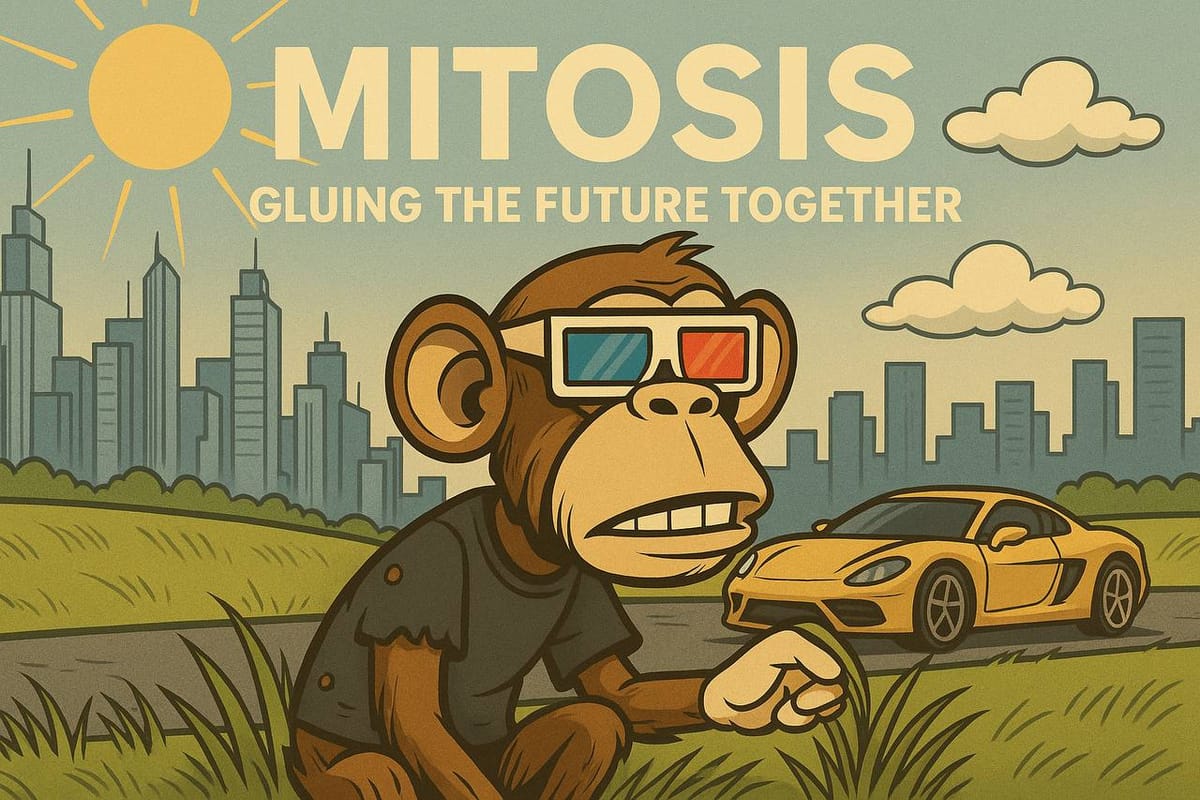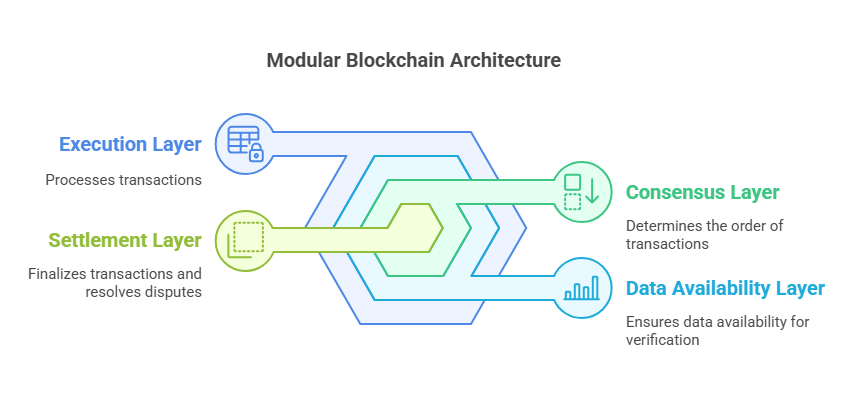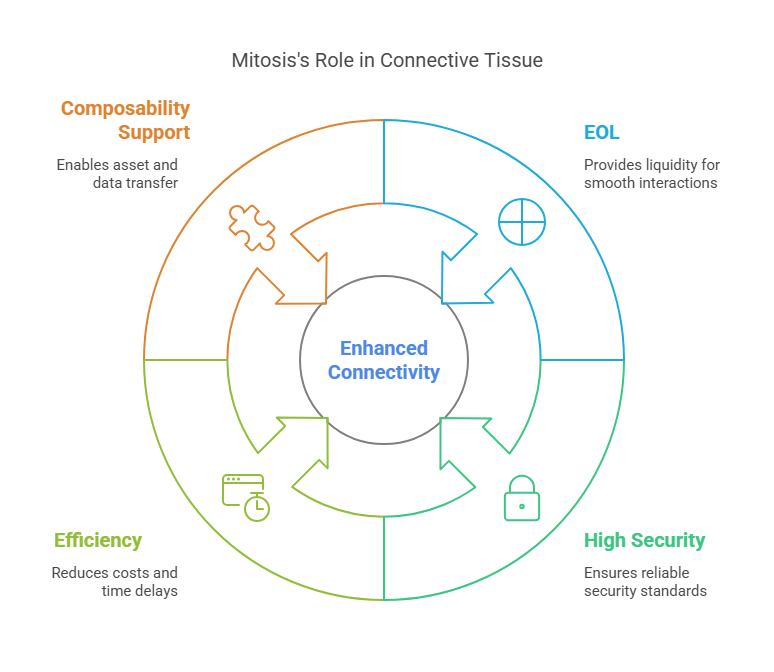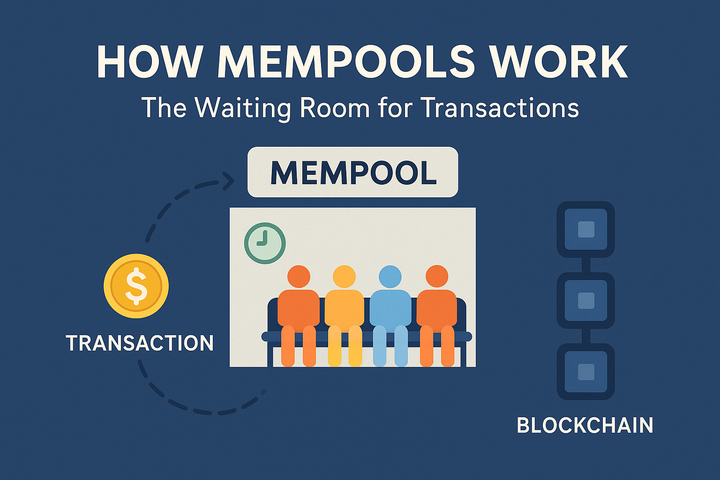Mitosis: Gluing the Future Together – An Indispensable Tool in the Modular Era of Web3

1. Introduction
A New Revolution: The Advent of Modular Blockchains
The blockchain industry is constantly evolving, and one of the hottest trends in recent years has been modular architecture. We are moving away from the era of "monolithic" blockchains, where a single network tried to do everything at once (transaction execution, data storage, consensus), towards a new paradigm. Modular blockchains separate these functions into specialized layers:
- Execution Layer: Processes transactions (e.g., rollups like Arbitrum, Optimism).
- Data Availability Layer: Ensures that transaction data is available for verification (e.g., Celestia).
- Consensus Layer: Determines the order of transactions.
- Settlement Layer: Finalizes transactions and resolves disputes.

This specialization promises incredible benefits: scalability, flexibility, sovereignty for developers, and the ability to create highly specialized blockchains (appchains) optimized for specific tasks – from DeFi and gaming to social networks. Projects like Celestia, Dymension, and the ecosystems of rollups on Ethereum are paving the way into this exciting modular future.
The Flip Side of Modularity: A New Era of Fragmentation
However, this revolution has a flip side. If the main problem before was fragmentation between a few large L1 networks, we are now moving towards a world with potentially thousands of specialized rollups, appchains, and L2 solutions. Each of them might have its own native assets, protocols, and liquidity pools.
This means that the problem of liquidity and user experience fragmentation not only persists but is exacerbated exponentially. How can a user easily move between a gaming appchain and a DeFi rollup? How can sufficient liquidity be ensured for trading assets that exist across hundreds of different but interconnected execution layers? Modularity is great in theory, but without effective communication mechanisms, it risks turning Web3 into an even more confusing and user-unfriendly labyrinth.
Mitosis: The Glue for the Modular World
This is precisely where Mitosis enters the scene. In the era of modularity, Mitosis ceases to be just "another" cross-chain solution. It becomes critically important infrastructure – a kind of "glue" or "binding agent" necessary for all these specialized modular components to interact effectively with each other.
Mitosis, with its focus on the secure and efficient movement of liquidity between networks, is ideally suited to address the problems generated by the modular paradigm. Its Ecosystem-Owned Liquidity (EOL) model and advanced security mechanisms (EigenLayer AVS) can provide the seamless flow of capital that is so needed for the modular ecosystem to thrive.
What Will You Learn From This Article?
In this article, we will delve into why protocols like Mitosis are becoming indispensable in the modular era. We will explore:
- The specific challenges that modularity creates for liquidity and UX.
- How Mitosis's architecture and features (EOL, security) address these challenges.
- The role of Mitosis in ensuring connectivity and composability between various rollups and appchains.
- Why the future of Web3 is likely to be not only modular but also interoperable, thanks to solutions like Mitosis.
2. Mitosis in Action: Solving the Problems of Modular Fragmentation
As established in the first part, modular architecture, despite its immense advantages, carries the risk of increased fragmentation. Let's now take a closer look at the specific tools and approaches Mitosis offers to overcome these challenges.
Challenge #1: Liquidity Silos
- The Problem: In the modular world, each rollup or appchain can become an isolated "island" of liquidity. Assets locked in one rollup are unavailable for use in another. This reduces overall capital efficiency and hinders the operation of DeFi protocols that require deep liquidity.
- The Mitosis Solution (EOL + Efficient Transport):
- Ecosystem-Owned Liquidity (EOL): Mitosis's key advantage is owning its own liquidity. Mitosis doesn't just wait for users to provide liquidity for a bridge; it can actively deploy its EOL liquidity to those modular networks (rollups, appchains) where it is most needed. This helps "seed" new networks with liquidity and ensure its availability for users.
- Seamless Transfers: Mitosis provides a fast and secure mechanism for transferring assets between these modular networks. A user can easily move their funds from a gaming appchain to a DeFi rollup without facing the limitations of isolated systems. Mitosis acts as a universal transport layer for assets.
Challenge #2: Poor User Experience (Poor UX)
- The Problem: Imagine a user needing to use three different bridges, manage assets in three different environments, and pay fees for each step just to interact with three different applications running on three different rollups. This is a nightmare from a UX perspective and will deter mass adoption.
- The Mitosis Solution (Complexity Abstraction):
- Single Point of Entry: Mitosis aims to become a unified interface or infrastructure layer for cross-chain interactions. Users won't need to search for a specific bridge for each transition between rollups; Mitosis can provide a universal route.
- Speed and Efficiency: By minimizing transfer times and costs, Mitosis makes multichain interaction less burdensome. Users can quickly switch between applications on different modular layers without losing time and money.
- (Potentially) Network Abstraction: Ideally, applications built using Mitosis could even abstract the underlying network away from the user. The user interacts with the application, and Mitosis handles the necessary cross-chain asset and data transfers "under the hood."
Challenge #3: Broken Composability
- The Problem: Composability is the "magic" of DeFi, allowing protocols to build on top of each other like Lego bricks. In the modular world, this composability is easily broken. A protocol on rollup A cannot directly interact with a protocol or assets on rollup B.
- The Mitosis Solution (Asset and Data Transfer):
- Asset Movement: As we've seen, Mitosis allows for easy movement of assets between modular networks. This already partially restores composability: you can withdraw an asset from a protocol on rollup A, transfer it via Mitosis, and use it in a protocol on rollup B.
- Message Passing (via Hyperlane): Mitosis utilizes messaging protocols like Hyperlane. This means it's potentially possible to transfer not only assets but also data or instructions between networks. This opens the way for creating more complex cross-chain applications where a smart contract on one rollup can call a function or check a state on another rollup, using Mitosis as a secure communication channel.
Challenge #4: Security at Scale
- The Problem: The proliferation of networks (rollups, appchains) means a proliferation of bridges and points of contact, and thus, a proliferation of potential attack vectors. Ensuring the security of every individual bridge for every rollup is a complex task.
- The Mitosis Solution (Unified Security Standard):
- High Baseline Security: By using cutting-edge solutions like EigenLayer AVS, Mitosis sets a high security bar for all its operations. Instead of relying on numerous bridges with varying levels of protection, the ecosystem can use Mitosis as a single, reliable standard for cross-chain interactions.
- Reduced Systemic Risk: Having one (or a few) well-secured and audited protocols like Mitosis reduces overall systemic risk compared to a situation where each network builds its own potentially vulnerable bridge.
Thus, Mitosis not only solves old cross-chain problems in a new context but also offers tools specifically suited for the unique challenges of the modular era, acting as the necessary connective tissue for the future of Web3.
3. The Future – Modular and Interoperable: The Role of Mitosis
The Synergy of Modularity and Interoperability
We've seen how modular architecture promises to revolutionize Web3, offering unprecedented scalability and flexibility. We've also seen how this very modularity creates new challenges related to the fragmentation of liquidity, user experience, and composability. It becomes clear that modularity itself is not a panacea. Its full potential can only be unlocked in synergy with powerful and secure solutions for interoperability.
Modular blockchains and interoperability protocols like Mitosis are not competing, but complementary technologies. Modularity creates specialized, efficient execution layers, while Mitosis provides seamless communication and asset flow between them. Without reliable "glue," the modular world risks remaining a collection of isolated, albeit high-performance, systems. With "glue" like Mitosis, it transforms into a unified, dynamic, and truly composable ecosystem.
Mitosis: A Key Element of Future Infrastructure
Mitosis, with its unique combination of features, fits perfectly into the role of this connective tissue:
- EOL: Provides the necessary liquidity to "grease the wheels" of interaction between modular networks.
- High Security (AVS): Offers a unified, reliable security standard, which is critically important in a world with thousands of potential interaction points.
- Efficiency: Reduces costs and time delays when moving between specialized rollups and appchains.
- Composability Support: Allows not only asset movement but also (via underlying messaging protocols) data transfer, paving the way for native cross-modular applications.

Imagine a future where a user can use an NFT from a gaming appchain as collateral in a DeFi protocol on another rollup, and then instantly transfer the resulting loan to a third rollup for staking – all without needing to understand which specific modular layers these applications run on. Mitosis is the infrastructure that can make such an experience a reality.
Conclusion: Building a Connected Modular World
The modular revolution has already begun, and it promises to change the Web3 landscape. But for this revolution to bring real benefits to users and developers, it needs reliable bridges and communication channels. Fragmentation is the main enemy of efficiency and usability, and the uncontrolled growth of modular networks exacerbates it.
Mitosis offers an elegant and powerful solution to this problem. Acting as the "glue" for the modular world, it ensures the secure and efficient flow of liquidity and data between disparate ecosystem components. It helps overcome liquidity silos, improve user experience, restore composability, and enhance overall security.
The future of Web3 will likely be not just modular – it will be modular and interoperable. And Mitosis has every chance to become one of the key protocols providing this necessary connectivity, helping to realize the full potential of the new era of blockchain technology.
Learn more about Mitosis:
- Explore details on the official website: https://www.mitosis.org/
- Follow announcements on Twitter: https://twitter.com/MitosisOrg
- Participate in discussions on Discord: https://discord.com/invite/mitosis
- Read articles and updates on Medium: https://medium.com/mitosisorg
- Blog: https://blog.mitosis.org/



Comments ()